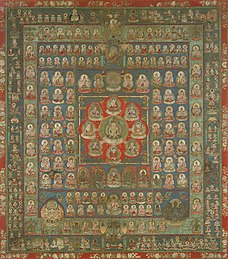
Back গর্ভক্ষেত্র Bengali/Bangla Monde de la matrice French Méhbirodalom Hungarian கர்பகோசதாது Tamil 胎藏界 Chinese

In Vajrayana Buddhism, the Womb Realm (Sanskrit: garbhakoṣadhātu, Traditional Chinese: 胎蔵界; Pinyin: Tāizāngjiè; Rōmaji: taizōkai) is the metaphysical space inhabited by the Five Compassion Buddhas. The Womb Realm is based on the Mahavairocana Tantra. The name of the mandala derives from chapter 2 of the sutra, where it is said that the buddha Mahāvairocana revealed the mandala's secret teachings to his disciple Vajrasattva from his "womb of compassion".[1] In other translations, the term Matrix Realm or Matrix Mandala is used.[2]
The Womb Realm is a very popular subject for mandalas, and along with the Diamond Realm (vajradhātu) Mandala forms the Mandala of the Two Realms. This mandala, along with the Diamond Realm, form the core of Chinese Tangmi and Japanese Tendai and Shingon Buddhist rituals, including abhisheka "initiation". In this ritual, new initiates are blindfolded and asked to toss a flower upon a mandala. Where the flower lands helps decide which Buddhist figure the student should devote themselves to.[3]
In traditional Tangmi and Shingon halls, the Womb Realm Mandala is hung on the east wall, symbolizing the young stage of Mahāvairocana.[4] In this setting, the Diamond Realm Mandala is hung on the west wall symbolizing the final realization of Mahāvairocana.[5]
- ^ Abe, Ryuichi (1999). The Weaving of Mantra: Kukai and the Construction of Esoteric Buddhist Discourse. Columbia University Press. ISBN 0-231-11286-6. PDF online
- ^ Hakeda, Yoshito S. (1972). Kūkai and His Major Works. Columbia University Press. p. 26. ISBN 0-231-05933-7.
- ^ Hakeda, Yoshito S. (1972). Kūkai and His Major Works. Columbia University Press. p. 44. ISBN 0-231-05933-7.
- ^ Hakeda, Yoshito S. (1972). Kūkai and His Major Works. Columbia University Press. p. 87. ISBN 0-231-05933-7.
- ^ David, Gardiner (1996). "On Mandalas". Journal of the International Association of Buddhist Studies. 19.
© MMXXIII Rich X Search. We shall prevail. All rights reserved. Rich X Search